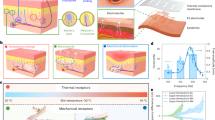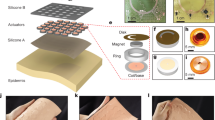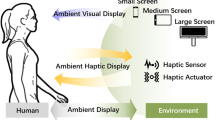Abstract
Haptic interfaces can be used to add sensations of touch to virtual and augmented reality experiences. Soft, flexible devices that deliver spatiotemporal patterns of touch across the body, potentially with full-body coverage, are of particular interest for a range of applications in medicine, sports and gaming. Here we report a wireless haptic interface of this type, with the ability to display vibro-tactile patterns across large areas of the skin in single units or through a wirelessly coordinated collection of them. The lightweight and flexible designs of these systems incorporate arrays of vibro-haptic actuators at a density of 0.73 actuators per square centimetre, which exceeds the two-point discrimination threshold for mechanical sensation on the skin across nearly all the regions of the body except the hands and face. A range of vibrant sensations and information content can be passed to mechanoreceptors in the skin via time-dependent patterns and amplitudes of actuation controlled through the pressure-sensitive touchscreens of smart devices, in real-time with negligible latency. We show that this technology can be used to convey navigation instructions, to translate musical tracks into tactile patterns and to support sensory replacement feedback for the control of robotic prosthetics.
This is a preview of subscription content, access via your institution
Access options
Access Nature and 54 other Nature Portfolio journals
Get Nature+, our best-value online-access subscription
$29.99 / 30 days
cancel any time
Subscribe to this journal
Receive 12 digital issues and online access to articles
$119.00 per year
only $9.92 per issue
Buy this article
- Purchase on Springer Link
- Instant access to full article PDF
Prices may be subject to local taxes which are calculated during checkout






Similar content being viewed by others
Data availability
The data that support the findings of this study are available from the corresponding author upon reasonable request.
Change history
28 August 2022
A Correction to this paper has been published: https://doi.org/10.1038/s41928-022-00842-7
References
Okamura, A. M. Haptic feedback in robot-assisted minimally invasive surgery. Curr. Opin. Urol. 19, 102–107 (2009).
Jones, M. G., Minogue, J., Tretter, T. R., Negishi, A. & Taylor, R. Haptic augmentation of science instruction: does touch matter? Sci. Edu. 90, 111–123 (2006).
Morris, D., Tan, H., Barbagli, F., Chang, T. & Salisbury, K. Haptic feedback enhances force skill learning. In Second Joint EuroHaptics Conference and Symposium on Haptic Interfaces for Virtual Environment and Teleoperator Systems (WHC’07) 21–26 (IEEE, 2007).
Bai, H., Li, S. & Shepherd, R. F. Elastomeric haptic devices for virtual and augmented reality. Adv. Funct. Mater. 31, 2009364 (2021).
Shi, Y. et al. Self-powered electro-tactile system for virtual tactile experiences. Sci. Adv. 7, eabe2943 (2021).
Yang, T. et al. Recent advances and opportunities of active materials for haptic technologies in virtual and augmented reality. Adv. Funct. Mater. 31, 2008831 (2021).
Biswas, S. & Visell, Y. Emerging material technologies for haptics. Adv. Mater. Technol. 4, 1900042 (2019).
Ankin, H. T. Y. K., Nirmal, A., Kulkarni, M. R., Accoto, D. & Mathews, N. Soft actuator materials for electrically driven haptic interfaces. Adv. Intell. Syst. 4, 2100061 (2021).
Fan, R. E. et al. A haptic feedback system for lower-limb prostheses. IEEE Trans. Neural Syst. Rehabil. Eng. 16, 270–277 (2008).
Holden, M. K. Virtual environments for motor rehabilitation: review. Cyberpsychol. Behav. 8, 187–211 (2005).
Zhu, M. et al. Haptic-feedback smart glove as a creative human-machine interface (HMI) for virtual/augmented reality applications. Sci. Adv. 6, eaaz8693 (2020).
HaptX. Haptic gloves for virtual reality and robotics. https://haptx.com/ (2021).
Bark, K. et al. Effects of vibrotactile feedback on human learning of arm motions. IEEE Trans. Neural Syst. Rehabil. Eng. 23, 51–63 (2015).
Choi, S. & Kuchenbecker, K. J. Vibrotactile display: perception, technology, and applications. Proc. IEEE 101, 2093–2104 (2013).
Jung, Y. H., Kim, J.-H. & Rogers, J. A. Skin-integrated vibrohaptic interfaces for virtual and augmented reality. Adv. Funct. Mater. 31, 2008805 (2021).
Yin, J., Hinchet, R., Shea, H. & Majidi, C. Wearable soft technologies for haptic sensing and feedback. Adv. Funct. Mater. 31, 2007428 (2021).
Wiliams, S. R. & Okamura, A. M. Body-mounted vibrotactile stimuli: simultaneous display of taps on the fingertips and forearm. IEEE Trans. Haptics 14, 432–444 (2021).
Rotella, M., Guerin, K., He, X. & Okamura, A. M. HAPI bands: a haptic augmented posture interface. In 2012 IEEE Haptics Symposium 163–170 (IEEE, 2012).
Kapur, P., Jensen, M., Buxbaum, L. J., Jax, S. A. & Kuchenbecker, K. J. Spatially distributed tactile feedback for kinesthetic motion guidance. In 2010 IEEE Haptics Symposium 519–526 (IEEE, 2010).
Lindeman, R. W., Page, R., Yanagida, Y. & Sibert, J. L. Towards full-body haptic feedback: the design and deployment of a spatialized vibrotactile feedback system. In Proc. ACM Symposium on Virtual Reality Software and Technology (VRST) 146–149 (ACM, 2018).
bHaptics. Next generation full body haptic suit—bHaptics TactSuit. https://www.bhaptics.com/ (2021).
TESLASUIT. Full body haptic feedback and motion capture tracking VR suit. https://teslasuit.io/ (2021).
Yu, X. et al. Skin-integrated wireless haptic interfaces for virtual and augmented reality. Nature 575, 473–479 (2019).
Mancini, F. et al. Whole-body mapping of spatial acuity for pain and touch. Ann. Neurol. 75, 917–924 (2014).
Xu, S. et al. Soft microfluidic assemblies of sensors, circuits, and radios for the skin. Science 344, 70–74 (2014).
Lee, K. et al. Mechano-acoustic sensing of physiological processes and body motions via a soft wireless device placed at the suprasternal notch. Nat. Biomed. Eng. 4, 148–158 (2020).
The Electronic Code of Federal Regulations (e-CFR) Title 47, 1.1310. Radiofrequency radiation exposure limits. https://www.ecfr.gov/cgi-bin/retrieveECFR?gp=&SID=81a1c5a13f8d02f165a 06af6937d612&mc=true&n=3pt47.1.1&r=PART&ty=HTML#se47.1.1_11310 (e-CFR, 2019).
Collotta, M., Pau, G., Talty, T. & Tonguz, O. K. Bluetooth 5: a concrete step forward toward the IOT. IEEE Commun. Mag. 56, 125–131 (2018).
Apple Inc. Human interface guidelines—3D touch. https://developer.apple.com/design/human-interface-guidelines/ios/user-interaction/3d-touch/ (2021).
Johnson, K. O. The roles and functions of cutaneous mechanoreceptors. Curr. Opin. Neurobiol. 11, 455–461 (2001).
Doxon, A. J., Johnson, D. E., Tan, H. Z. & Provancher, W. R. Human detection and discrimination of tactile repeatability, mechanical backlash, and temporal delay in a combined tactile-kinesthetic haptic display system. IEEE Trans. Haptics 6, 453–463 (2013).
Shao, Y., Hayward, V. & Visell, Y. Spatial patterns of cutaneous vibration during whole-hand haptic interactions. Proc. Natl Acad. Sci. USA 113, 4188–4193 (2016).
Jeong, H. et al. Differential cardiopulmonary monitoring system for artifact-canceled physiological tracking of athletes, workers, and COVID-19 patients. Sci. Adv. 7, eabg3092 (2021).
Solav, D., Moerman, K. M., Jaeger, A. M., Genovese, K. & Herr, H. M. MultiDIC: an open-source toolbox for multi-view 3D digital image correlation. IEEE Access 6, 30520–30535 (2018).
Joyce, G. C. & Rack, P. M. H. The effects of load and force on tremor at the normal human elbow joint. J. Physiol. 240, 375–396 (1974).
Moffatt, H. K. Euler’s disk and its finite-time singularity. Nature 404, 833–834 (2000).
Royston, T. J. et al. Estimating material viscoelastic properties based on surface wave measurements: a comparison of techniques and modeling assumptions. J. Acoust. Soc. Am. 130, 4126–4138 (2011).
Bedford, A. & Drumheller, D. Elastic Wave Propagation (John Wiley & Sons, 1994).
Kiss, F., Boldt, R., Pfleging, B. & Schneegass, S. Navigation systems for motorcyclists: exploring wearable tactile feedback for route guidance in the real world. In Proc. 2018 CHI Conference on Human Factors in Computing Systems (CHI) 617 (ACM, 2018).
Tanaka, A. & Parkinson, A. Haptic wave: a cross-modal interface for visually impaired audio producers. In Proc. 2016 CHI Conference on Human Factors in Computing Systems (CHI) 2150–2161 (ACM, 2016).
Fan, R. E. et al. Pilot testing of a haptic feedback rehabilitation system on a lower-limb amputee. In 2009 ICME International Conference on Complex Medical Engineering 1–4 (IEEE, 2009).
Kim, K. & Colgate, J. E. Haptic feedback enhances grip force control of semg-controlled prosthetic hands in targeted reinnervation amputees. IEEE Trans. Neural Syst. Rehabil. Eng. 20, 798–805 (2012).
Ko, S. H. & Rogers, J. A. Functional materials and devices for XR (VR/AR/MR) applications. Adv. Funct. Mater. 31, 2106546 (2021).
Wu, H.-Y. et al. Eulerian video magnification for revealing subtle changes in the world. ACM Trans. Graph. 31, 65 (2012).
Acknowledgements
Y.H.J. acknowledges support from the National Research Foundation of Korea (NRF) grant funded by the Korean Government (MSIT) (no. 2022R1C1C1003994) and the research fund of Hanyang University (HY-202100000000832). We thank the Querrey Simpson Institute for Bioelectronics for support of this work.
Author information
Authors and Affiliations
Contributions
Y.H.J. and J.A.R. conceived the idea, designed the research, analysed the data and wrote the manuscript. Y.H.J., J.-Y.Y., A.V.-G., J.-H.K., M.P., J.L. and C.-J.S. designed the device and carried out the fabrication. A.V.-G., R.S. and J.T. designed the operation protocols and GUI. J.-T.K., H.L. and R.A. performed the mechanical characterization and analysis. A.A. and J.C. designed and programmed the prosthetic hand. Y.H.J., J.-Y.Y, A.V.-G., J.-H.K., H.-S.S., C.-J.S., J.-K.C., D.S.Y., Y.P., H.R., H.-J.Y., G.L., H.J., J.U.K., T.-I.K. and Y.H. carried out the experimental validation and analysis.
Corresponding author
Ethics declarations
Competing interests
The authors declare no competing interests.
Peer review
Peer review information
Nature Electronics thanks Herbert Shea, Xiaoming Tao and the other, anonymous, reviewer(s) for their contribution to the peer review of this work.
Additional information
Publisher’s note Springer Nature remains neutral with regard to jurisdictional claims in published maps and institutional affiliations.
Supplementary information
Supplementary Information
Supplementary Figs. 1–19, Tables 1 and 2 and and Notes 1 and 2.
Supplementary Video 1
Vibration analysis of an ERM actuator with PTV.
Supplementary Video 2
Vibration analysis of an ERM actuator with DIC.
Supplementary Video 3
High-speed video imaging of various actuators.
Supplementary Video 4
Enhanced video imaging of various actuators.
Supplementary Video 5
Spatiotemporal haptic patterns of actuation for various touch interactions.
Supplementary Video 6
Translation of sound into haptic feedback in real time.
Supplementary Video 7
Prosthetic tactile feedback training.
Supplementary Video 8
Grasping an eggshell using a prosthetic hand without haptic feedback.
Supplementary Video 9
Grasping an eggshell using a prosthetic hand with haptic feedback.
Rights and permissions
Springer Nature or its licensor holds exclusive rights to this article under a publishing agreement with the author(s) or other rightsholder(s); author self-archiving of the accepted manuscript version of this article is solely governed by the terms of such publishing agreement and applicable law.
About this article
Cite this article
Jung, Y.H., Yoo, JY., Vázquez-Guardado, A. et al. A wireless haptic interface for programmable patterns of touch across large areas of the skin. Nat Electron 5, 374–385 (2022). https://doi.org/10.1038/s41928-022-00765-3
Received:
Accepted:
Published:
Issue Date:
DOI: https://doi.org/10.1038/s41928-022-00765-3
This article is cited by
-
Adaptive tactile interaction transfer via digitally embroidered smart gloves
Nature Communications (2024)
-
Anti-friction gold-based stretchable electronics enabled by interfacial diffusion-induced cohesion
Nature Communications (2024)
-
Material and structural considerations for high-performance electrodes for wearable skin devices
Communications Materials (2024)
-
A site-selective integration strategy for microdevices on conformable substrates
Nature Electronics (2024)
-
Active electronic skin: an interface towards ambient haptic feedback on physical surfaces
npj Flexible Electronics (2024)



